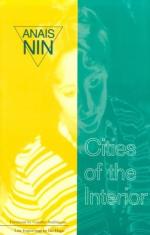|
This section contains 337 words (approx. 2 pages at 300 words per page) |

|
Perhaps the most noticeable quality which runs throughout Cities of the Interior and all of Nin's fiction and diaries is her abundant use of evocative imagery. All of her writing bears her unmistakable flair for the lyrical poetic image which appeals to the senses more than the reason. She has noted that she hoped her writing, like painting and music, would make its appeal primarily to the senses. The inward journeys of her characters are not ones which can be comprehended fully by the rational faculties. They must be felt. She is eager to dissolve the distinctions between subjective and objective, fantasy and fact, poetry and prose, autobiography and fiction.
"Art," she writes in The Novel of the Future (1968), "is revealing to us the variety of levels on which we live." To be true to life a writer must reflect these various levels by suggesting the rich interior...
|
This section contains 337 words (approx. 2 pages at 300 words per page) |

|




